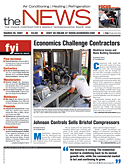
“It seems that contractors are hesitating to embrace this and educate their clients about the phaseout of R-22 and the reduced availability of it in 2010,” commented Russ Donnici, president, Mechanical Air Service, San Jose, Calif.
Emerging technology changes included the advanced onboard diagnostic systems and the myriad of software and devices designed to make business easier, more accurate, and more efficient.
Contractors were excited and concerned about the new onboard smart technology that hit the market in 2007. “We need to embrace technology and constantly look for new ways to do business,” said Jeff Somers, vice president and COO, Monsen Engineering Co., Fairfield, N.J. “Technology, however, should be used wisely and carefully. It’s easy to be overwhelmed and make a bad choice, or worse yet, no choice.” According to Jim Hussey, president and CEO, Marina Mechanical, San Leandro, Calif., in the short term, technology has a lot to offer in the improvement of efficiency and productivity.
“Long term, I am concerned that technology - particularly the ability to self-diagnose and report pending failures directly to the manufacturer - may eliminate the need for the contractor and leave them with the high-risk role of labor broker as their only value proposition.”
He also saw lean manufacturing and production as migrating to lean contracting, which he considers to be the next tool for contractors to protect margins. Workforce issues continued to plague the HVAC industry this past year. Not only did the manpower shortage make it difficult to control escalating labor costs, but also the number of retiring Baby Boomers continued to increase, intensifying the growing labor shortage.
The largest challenge to tackle, however, was the economy. Economists argued greatly as to whether or not 2007 was a year of impending recession. According to the Sheet Metal and Air Conditioning Contractors’ National Association (SMACNA), about one-half of the economists, like Nouriel Roubini, professor of economics, New York University, predicted that “we’re in for a much nastier, deeper, and more protracted recession than the one in 2001, as sales of existing homes decline and inventories rise.”
“As the economy goes through an overhaul this year and the phone stops ringing, we are going to see many contractors fold,” cautioned Bodwell. “Those that are planning for a slowdown in the economy are going to grow and prosper.”
In the midst of economic change, a housing market slump, and countless consolidation concerns, politics were another factor affecting the local contractor.
“I think this may be a lame duck political year that will generate some major turmoil,” said Bodwell. “We as an industry need to unite and lobby for what’s important to our business health. The key issue in 2007 was business survival.”
Publication Date:12/24/2007

Report Abusive Comment